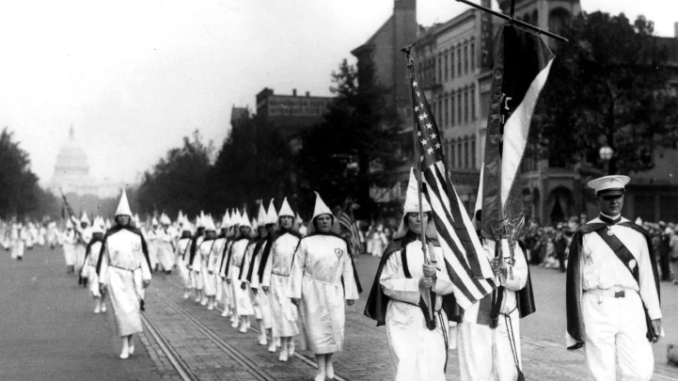
Dozens of feature articles have recently marvelled at the increasingly female face of the far right in Europe and North America. The New York Times reported, for instance, on the increased visibility of women in the upper-echelons of far-right parties, from France to Norway. A Vogue feature described this as “the friendly face of right-wing politics,” and “an attempt to soften and feminise” the European far right’s extreme views.
In North America, numerous reports have asked what draws women to radical conservative and ‘alt-right’ movements.
In Canada, the Montreal Gazette said far-right women are “coming out of the shadows” in Quebec to participate in anti-immigrant, anti-Muslim campaigns in growing numbers. Marie Claire said such apparent trends were nothing less than “shocking.”
The core question posed by such pieces is: Why are women joining far-right movements? But we must also ask: Why are we so surprised? After all, these issues are not new. “What attracts women to far-right movements that appear to denigrate their rights? This question has vexed feminist scholars for decades,” is how one historian put it. “The uncomfortable truth is that women also have a long history in far-right movements.”
The far right is often seen or assumed to be toxically masculine and a no-go zone for women. But the uncomfortable truth is that women also have a long history in far-right movements. Women played key roles in white supremacist movements in the United States, for example, including as propagandists and figureheads.
“There’s no reason to expect women to be less bigoted than men,” historian Linda Gordon concluded. Her research into the Klu Klux Klan (KKK) estimated that at least 1.5 million American women were members in the 1920s, including one third of all white Protestant women living in Indiana. “Women organised Klan rights of passage, baptisms, graduations, marriages and funerals,” Gordon said in a recent interview. Some women, who “may not have been vigilantes themselves, nevertheless, supported vigilantism.” she added.
In the 1990s, US academic Glen Jeansonne wrote about far-right women in America during the second world war, and the so-called “mothers’ movement” which opposed US intervention but was not pacifist; its ideology was instead a mix of militant Christianity, anti-communism and anti-Semitism, he said.
Twentieth century fascist movements in Europe were known for stressing women’s responsibilities at home. In Italy, conservative ideals of good Fascist mothers and wives were prominent in propaganda campaigns. Thousands of non-conforming women were locked in asylums for ‘moral deviancy’. In Germany, it was Kinder, Küche, and Kirche (children, kitchen, and church).
Our history books are products of our societies too. Historians have also been influenced by “prevailing prejudices about the ‘apolitical’ nature of women,” and women’s supposed “predilection for the domestic sphere,” noted one academic. Has women’s participation been overlooked because researchers assumed they were just subjects, or ‘victims,’ of far-right regimes?
“Has women’s participation been overlooked because researchers assumed they were just subjects, or ‘victims,’ of far-right regimes?”
“The common assumption [is] that fascism is a misogynist movement which has tended to exclude women,” according to researcher Martin Durham who contrasted this with cases of women’s active participation in fascist politics in France, Germany, Italy and the UK.
In Spain, the fascist Sección Femenina (SF) was “one of the most highly organised, mass women’s organisation in Spanish history,” and a “formidable political force,” said one account. Among other things it organised social assistance programmes and mass vaccination campaigns.
The SF’s promoted an ‘ideal woman’ who was self-sacrificing and obedient to men, but it was also seen by some women as empowering as it recognised and respected their otherwise neglected labour caring for children and other relatives. In the 1960s, the SF also successfully lobbied for new legislation on women’s labour rights.
Mosley’s movement even appealed to some former suffragettes. Though it has “traditionally been seen as predominantly an aggressively male movement,” there was “extensive participation of women,” said author Martin Pugh.
Some women received training in jiujitsu to throw female Communists out of meetings. Others went door-to-door to campaign for support and canvas for votes, presenting “a more reassuring image of fascism than that created by street violence and mass demonstrations.”
“Fascism’s relationship with women has been neither consistent nor predictable,” is Durham’s conclusion. While men may have been more visible in such movments, large numbers of women also participated as voters, members, fundraisers, marchers, party officials, and more.
Contibuted by, Heather B.
This article is from the year 2018, however, it relates to white women today as much as it did then. Looking at history, women have long played a role in keeping our society running in a proper fashion and without communism. There should be no surprise that women are voting for the far-right today. Women do want to be recognized for their efforts in keeping conservative ideals. We have long stood our gound. – Heather B.
* Original Article:
https://www.opendemocracy.net/en/5050/women-far-right-movements-why-are-we-surprised/
